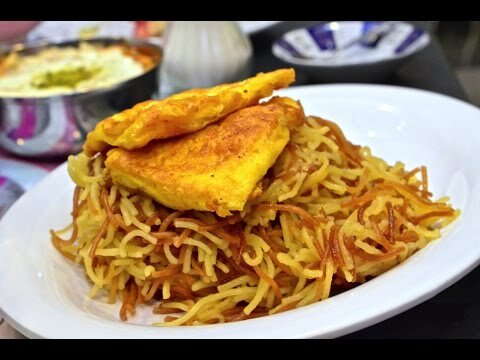That Translator Can Cook: Balaleet
Fried vermicelli noodles spiced with sugar, cinnamon, saffron, cardamom, and orange blossom/rose water, topped with a thin egg omelet.
Image Source: YouTube
I’ve had a version of this in Palestine, except without the egg. It tasted pretty good, especially the noodles that were crispy from the frying. I like things crispy and not too sweet, so when I cook this for myself, I would fry the noodles longer and maybe sprinkle salt or something with a kick to reduce the sweetness.
Balaleet is popular in the Gulf countries, but it is considered to be a traditional Emirati dish. In the UAE, expatriates make up almost 90% of the population, so ‘traditional’ refers to dishes that originated with the Bedouins and were prevalent before the oil boom; they included lots of meat (camel, goat, fish, etc.) and complex carbohydrates. Lots of the spices used in Emirati dishes (i.e. turmeric, saffron, cardamom, and cinnamon) were spices brought to the UAE by Indian merchants. The addition of vermicelli came with traders during the Middle Ages; it is said that balaleet was created when Emiratis experimented with the pasta.
Balaleet is both breakfast and dessert: it is served warm for breakfast and served cold for dessert. While it is eaten as breakfast at almost any time throughout the year, I get the impression that it’s served as dessert during Ramadan. Balaleet is similar to faloodeh (Persian) and sheer kurma (Indian), suggesting that the creation of the dish was influenced by merchants from the East.
Here is how to make balaleet. The recipe belongs to kakawa3.
Ingredients
1 package of Kuwaiti Mills vermicelli or any other kind you prefer
1 cup of sugar, maybe a bit more if you prefer
5 eggs
3 spoonfuls of ground cardamom
3 spoonfuls of saffron
1/2 cup of rosewater
A dash of salt and pepper
A dash of fennel flower (optional)
Some water for boiling the vermicelli
Oil for simple frying
Steps
First, take the rosewater and add the cardamom and saffron to it. Let it steep, God willing, you will use it after a short while. Boil the water, then the vermicelli with a little bit of oil so that it doesn’t stick together. Let it boil for 5 minutes because it becomes al dente quickly, especially the thin kind.
Put the vermicelli in a colander and strain the water for some time. Then, add the sugar to it in the colander and quickly toss it.
In the same pot used for boiling the vermicelli, pour in a little bit of oil, then add the vermicelli immediately. Toss it for a bit on low heat.
Add the saffron infusion to the vermicelli and toss until the infusion is completely distributed throughout the mixture. Cover the pot and lower the heat. Let it simmer for a few minutes.
Meanwhile, fry the eggs separately (so they’re like discs); sprinkle the salt, pepper, and fennel flower; and flip them over.
Serve the vermicelli on a flat, wide platter and add the egg rounds over top of it. Bon appetiiiiit!
Note: The amount of sugar may be increased or decreased as much as you want; you can add sugar the vermicelli in the colander or the pot. It will all end up the same. Bon appetiiiit!
Translators’ Discussion
In Arabic, ملعقة صغيرة is teaspoon and ملعقة كبيرة is tablespoon, but the recipe used ملاعق وسط, which means “spoons” and “middle/medium.” So, I went with “spoonfuls.” How would have translated this?
I feel like ‘simple frying’ (القلي البسيط) is too literal, or there’s a cultural or cooking component I’m missing. What do you think?
I tried to find a way to phrase “نقلي البيض على شكل قرص” in an idiomatic yet accurate and descriptive way. Do you think “fry the eggs separately (so they’re like discs)” achieves this, or is there a better way to phrase it?

